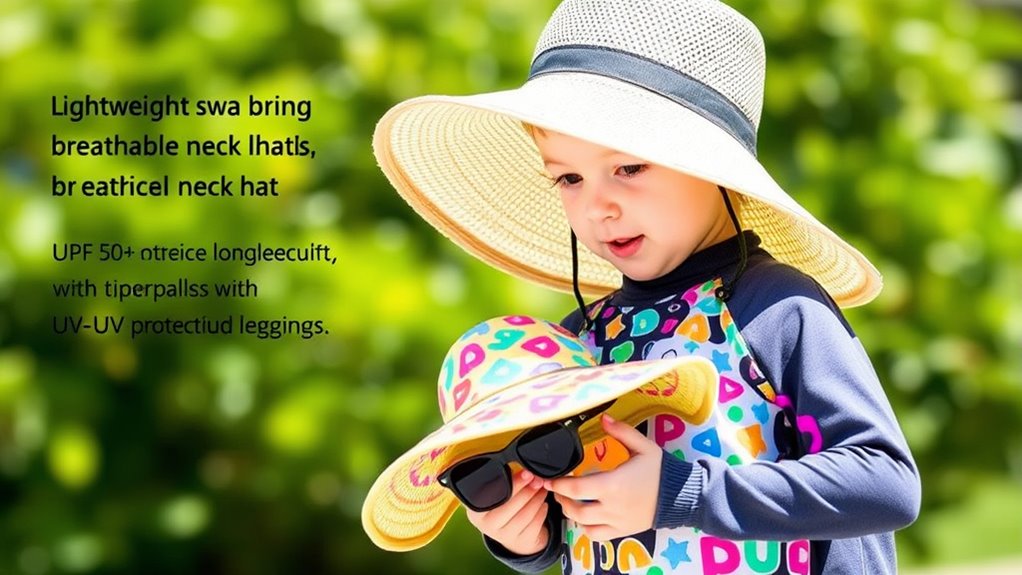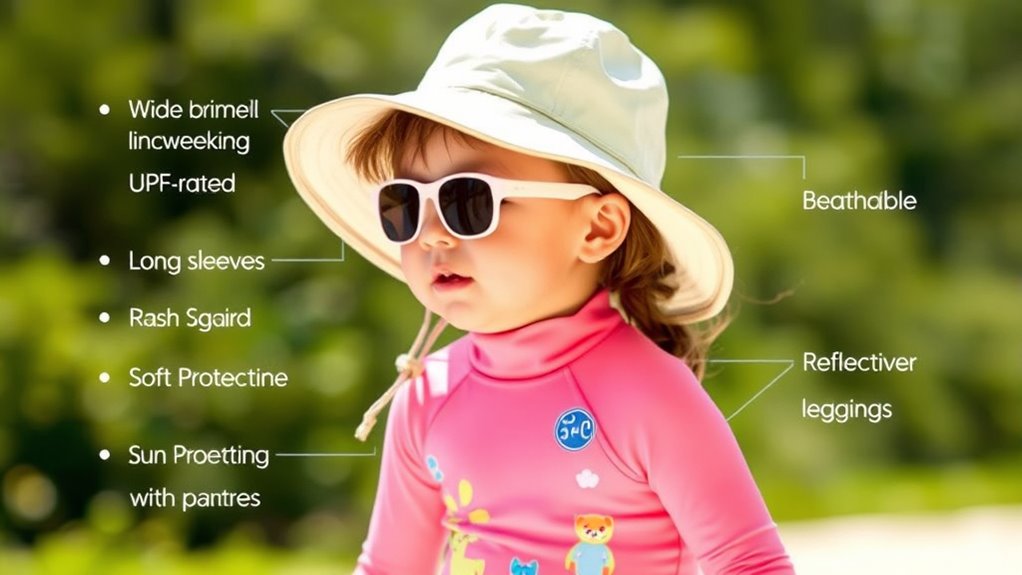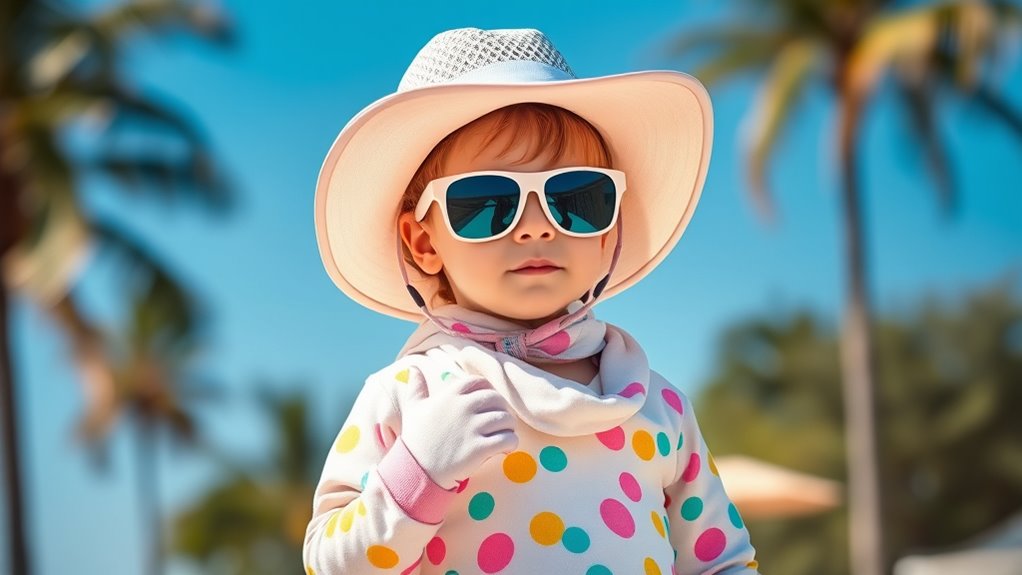To protect your child from the sun, choose clothing with a UPF 30+ rating or higher, like long-sleeve shirts, wide-brimmed hats, and sunglasses made for UV protection. Opt for lightweight, tightly woven fabrics in bright or dark colors for better defense. Add accessories such as sun blankets or swim rashguards for water activities. Focusing on coverage, comfort, and proper fabric helps keep your child safe—so keep exploring to learn more tips for effective sun protection.
Key Takeaways
- Choose UPF 50+ rated clothing like long sleeves, rashguards, and sun shirts for maximum UV protection.
- Opt for wide-brimmed hats and UV-protective sunglasses to shield the face, ears, and eyes effectively.
- Select tightly woven, lightweight, and moisture-wicking fabrics in dark or bright colors for better UV blocking.
- Layer clothing for adaptable sun protection and comfort during different weather or activity levels.
- Use accessories such as sun blankets and baby covers made with UV-protective materials to enhance overall safety.
Types of Sun-Protective Clothing for Children

When choosing sun-protective clothing for children, it’s important to understand the different types available to guarantee they stay safe during outdoor activities. Long sleeve tees offer full coverage and can be layered or worn alone. Rashguards are popular for water play, providing comfort and protection in the water. Sun shirts with UPF 50+ are designed specifically for outdoor use, keeping kids safe from harmful rays. Crewnecks are versatile and suitable for casual wear while offering sun protection. For girls, dresses with built-in sun protection combine style with safety. These options ensure your child stays protected during outdoor fun, whether they’re playing, swimming, or exploring. Choosing the right clothing helps minimize sun exposure and keeps them comfortable all day long. Additionally, selecting appropriate sun protective clothing that reflects the latest safety standards can provide extra peace of mind during outdoor family outings. Incorporating creative practices such as choosing innovative fabrics and designs can further enhance sun protection and comfort, especially when considering UV protection technologies that integrate seamlessly into children’s apparel.
Key Fabric Technologies and UPF Ratings

Understanding fabric technologies and UPF ratings is essential for choosing effective sun-protective clothing for children. UPF measures how well fabric blocks UV rays, with UPF 50+ blocking at least 98%, providing excellent protection. Fabrics with higher knit density and specialized fibers, like polyester, nylon, or those infused with zinc oxide, offer better UV defense. These ratings remain stable through washing and wear, ensuring long-lasting protection. Dense knitting physically blocks UV penetration, while chemical treatments can enhance UV absorption. Breathable, moisture-wicking fabrics improve comfort during outdoor activities. Proper care, such as gentle washing and avoiding bleach, preserves UPF performance. Fabric technology plays a crucial role in UV protection, as advanced fibers and treatments can significantly improve a garment’s sun-blocking capabilities. Additionally, UV resistance can be enhanced through innovative textile engineering, making it easier to find durable, effective clothing that keeps your child safe from harmful sun exposure. Incorporating UV protective finishes can further boost a fabric’s ability to shield against ultraviolet rays, ensuring comprehensive protection. An understanding of UV blocking materials helps in selecting the most effective clothing options for children.
Advantages of Sun-Protective Clothing Over Sunscreen Alone

Sun-protective clothing offers several advantages over relying on sunscreen alone. It provides consistent UV protection that doesn’t wear off or require frequent reapplication, unlike sunscreen, which needs reapplying every two hours or after swimming or sweating. Clothing acts as a physical barrier, covering vulnerable areas like the back of hands, neck, and ears, reducing missed spots common with lotion. Certified UPF fabrics block over 98% of UV rays, including both UVA and UVB, ensuring broader, more reliable protection. Modern UPF clothing is breathable, moisture-wicking, and comfortable, making it ideal for active children. Plus, it eliminates the greasy or sticky feeling of sunscreen and avoids skin irritation. With tested and standardized protection, sun-protective clothing offers a safer, more dependable way to shield your child from harmful UV exposure. Understanding of UV protection is essential for choosing the most effective sun safety options. Additionally, advancements in fabric technology have made UPF clothing more stylish and functional, encouraging consistent use. Recognizing sun safety behaviors can further enhance protection and reduce the risk of sun damage in children. Incorporating integrated UV protection into daily routines can also reduce the reliance on topical products and ensure continuous coverage. Moreover, educating caregivers about proper sun safety measures can significantly improve outdoor protection for children.
Essential Accessories for Child Sun Protection

Essential accessories play a crucial role in safeguarding your child from harmful UV rays, especially in areas that are difficult to shield with clothing or sunscreen alone. Wide-brimmed hats are your best option, covering the face, neck, and ears effectively, while lightweight, breathable fabrics like cotton or linen keep kids cool. Adjustable straps or chin ties help hats stay secure during active play. UV-protective sunglasses shield delicate eyes, and accessories like baby covers or sun blankets add extra layers of defense. UPF 50+ certified items ensure maximum protection. Incorporating sustainable sun protection practices can enhance overall safety and environmental responsibility. Additionally, selecting accessories made with UV-blocking materials can provide even more reliable protection. Using appropriate fabric choices in hats and clothing can also improve breathability and comfort. Choosing accessories with effective UV protection ensures comprehensive defense against harmful rays. Incorporating sunscreen application techniques and protective accessories creates a thorough shield against UV rays, helping your child stay safe and comfortable outdoors. Prioritizing comfort and practicality encourages consistent use.
Tips for Selecting Clothing and Accessories

Choosing the right clothing and accessories for your child’s sun protection involves paying attention to several important factors. First, look for garments with a UPF rating of 30 or higher, as they block most UV rays. Fabrics that are tightly woven, like polyester or zinc oxide-infused materials, offer better protection than loose weaves or regular cotton. Opt for dark or bright colors, which absorb more UV radiation, and choose long-sleeved shirts and full-length pants to cover exposed skin. A wide-brimmed hat provides added face and neck protection. Pick lightweight, breathable fabrics that are comfortable and allow airflow during active play. Ensure clothing fits well—neither too tight nor too loose—and is durable enough to withstand frequent washing without losing protective qualities. Additionally, water-resistant fabrics can help keep your child dry and comfortable during outdoor activities. Considering UV protection clothing options can further enhance safety and convenience during outdoor adventures. Properly designed sun-protective clothing often features specialized fabric technology that maintains UV-blocking properties even after multiple washes. Regularly checking UV protection ratings can help ensure your child’s clothing continues to provide effective sun protection. Incorporating moisture-wicking materials can also help keep your child cool and dry on hot, sunny days.
Practical Considerations and Usage

Ensuring effective sun protection for your child requires careful attention to practical factors such as coverage, fabric choice, and comfort. Make certain their clothing fully covers exposed skin, using lightweight, tightly woven fabrics like cotton that balance protection and breathability. Long sleeves and pants extend coverage, while wide-brimmed hats shield the face, ears, and neck better than baseball caps. Choose dark or bright colors, as they absorb more UV radiation, providing added protection. Ensure the clothing fits well to prevent discomfort or removal, and opt for lightweight fabrics in hot weather to prevent overheating. Durable materials that withstand frequent washing help maintain UV-blocking properties. Dressing children in layers allows you to adapt to changing weather and activity levels, maximizing their sun safety. Additionally, selecting clothing with UV protection ratings can offer an extra layer of security against harmful rays.
Frequently Asked Questions
How Often Should I Replace My Child’s Sun-Protective Clothing?
You should replace your child’s sun-protective clothing when you notice signs of wear, like fading, thinning fabric, or stretched fibers, which reduce effectiveness. Typically, UPF clothing lasts about one to two years with proper care. Regularly inspect the garments, wash them gently, and store them properly. If they no longer provide reliable protection or show significant damage, it’s time to get new pieces to keep your child safely protected from the sun.
Are There Specific Styles or Colors That Encourage More Consistent Wear?
You’re wondering which styles or colors encourage your child to wear sun protection clothing consistently. Bright, vivid shades like coral or pink attract their attention and boost enthusiasm. Fun patterns with familiar themes, like nautical animals, make the clothing more appealing. Choose comfortable, familiar styles like hoodies or t-shirts, and let your child pick their favorite colors. When the clothing feels fun and normal, they’re more likely to wear it regularly.
Can Sun-Protective Fabrics Be Washed With Regular Laundry?
You might wonder if sun-protective fabrics can go in your regular laundry. Yes, you can wash them with your usual laundry, but you need to take precautions. Use cold or lukewarm water, a gentle detergent, and avoid bleach or fabric softeners. Dry them by hanging up or line drying, and steer clear of high heat. Proper care keeps your fabric’s UV protection intact and lasts longer.
Is UPF 50+ Protection Effective After Multiple Washes?
You wonder if UPF 50+ protection stays effective after multiple washes. It generally does, especially if the garment uses inherent UV-blocking fibers or durable construction methods. Brands like Coolibar design fabrics to maintain UPF 50+ even after many washes. To keep protection high, follow care instructions, wash gently, and inspect for wear. Replacing garments after extensive washing is wise if you notice fading or reduced UV effectiveness.
How Can I Ensure a Proper Fit for My Child’s Sun-Protective Accessories?
To guarantee a proper fit for your child’s sun-protective accessories, start by measuring their head and face regularly since children grow quickly. Choose adjustable hats and sunglasses with secure straps to keep them in place during active play. Make sure the accessories aren’t too tight or too loose, allowing free movement and comfort. Always check that the fit provides full coverage without causing discomfort, encouraging your child to wear them consistently outdoors.
Conclusion
Think of sun protection like armor for your child’s adventure in the outdoors. Just as a knight shields themselves with a sturdy suit, the right clothing and accessories guard your little one from harsh rays. When you choose wisely, you’re equipping them with an invisible shield that keeps them safe while they explore, play, and grow. Embrace these tools, and watch your child’s sunny days become joyful, worry-free adventures under the protective umbrella of thoughtful sun safety.









